Colour Stabilisation of Surface of Four Thermally Modified Woods with Saturated Water Vapour by Finishes
Abstract
:1. Introduction
2. Materials and Methods
2.1. Sample Preparation and Finishing
- •
- One-component water-based acrylic-polyurethane dispersion surface finish, Aqua TL-412-Treppenlack/50. It is recommended for use on solid wood, veneers, wooden stairs, and living room and bedroom furniture. It is an abrasion-resistant finish with a high solids content.
- •
- Two-component surface finish with polyacrylic and aldehyde resin, PUR SL-212-Schichtlack/30. It is recommended for use on solid wood, veneers, tables and worktops, and kitchen and bathroom furniture. It is highly scratch-resistant and full-built.
- •
- Single-component wood sealer with alkyd resin, HWS-112-Hartwachs-Siegel/clear. It is recommended for use on furniture, tables and worktops, bathroom and sauna elements, floors and stairs, cork floors, and bamboo components.
2.2. Natural Sunlight Ageing
2.3. Colour Analyses
2.4. Statistical Evaluation
3. Results and Discussion
3.1. Initial Colour of Wood and Effect of Finish Application
3.2. Effects of Natural Sunlight Ageing on Differences in ∆L*, ∆a*, ∆b*, ∆C*ab, and ∆hab
3.3. Effects of Natural Sunlight Ageing on Effects on Difference in Yellowness Index
3.4. Effects of Natural Sunlight Ageing on Total Colour Difference ∆E*ab
4. Conclusions
Author Contributions
Funding
Institutional Review Board Statement
Informed Consent Statement
Data Availability Statement
Acknowledgments
Conflicts of Interest
References
- Sandberg, D.; Kutnar, A.; Karlsson, O.; Jones, D. Wood Modification Technologies: Principles, Sustainability, and the Need for Innovation, 1st ed.; Taylor and Francis Ltd.: Abingdon, UK, 2021; 450p, ISBN 978-1-138-49177-9. [Google Scholar]
- Tolvaj, L.; Nemeth, R.; Varga, D.; Molnar, S. Colour homogenisation of beech wood by steam treatment. Drewno 2009, 52, 5–17. [Google Scholar]
- Timar, M.C.; Varodi, A.M.; Hacibektasoglu, M.; Campean, M. Color and FT-IR analysis of chemical changes in beech wood (Fagus sylvatica L.) after light steaming and heat treatment in two different environments. BioResources 2016, 11, 8325–8343. [Google Scholar] [CrossRef] [Green Version]
- Dudiak, M.; Dzurenda, L. Changes in the physical and chemical properties of alder wood in the process of thermal treatment with saturated water steam. Coatings 2021, 11, 898. [Google Scholar] [CrossRef]
- Dzurenda, L.; Dudiak, M. Changes in wood tree species Fagus sylvatica L. and characteristics of the thermal process of modifying its color with saturated water steam. Appl. Ecol. Environ. Res. 2020, 5, 142–156. [Google Scholar]
- Geffert, A.; Geffertová, J.; Výbohová, E.; Dudiak, M. Impact of steaming mode on chemical characteristics and color of birch wood. Forests 2020, 11, 478. [Google Scholar] [CrossRef] [Green Version]
- Dudiak, M. Modification of maple wood colour during the process of thermal treatment with saturated water steam. Acta Fac. Xylologiae Zvolen 2021, 63, 25–34. [Google Scholar]
- Vidholdová, Z.; Sandak, A.; Sandak, J. Assessment of the chemical change in heat treated pine wood by near infrared spec-troscopy. Acta Fac. Xylologiae Zvolen 2019, 61, 31–42. [Google Scholar]
- Paulsson, M.; Parkås, J. Review: Light-induced yellowing of lignocellulosic pulps—Mechanisms and preventive methods. BioResources 2012, 7, 5995–6040. [Google Scholar] [CrossRef] [Green Version]
- George, B.; Suttie, E.; Merlin, A.; Deglise, X. Photodegradation and photostabilisation of wood—The state of the art. Polym. Degrad. Stab. 2005, 88, 268–274. [Google Scholar] [CrossRef]
- Deka, M.; Humar, M.; Rep, G.; Kričej, B.; Šentjurc, M.; Petrič, M. Effects of UV light irradiation on colour stability of thermally modified, copper ethanolamine treated and non-modified wood: EPR and DRIFT spectroscopic studies. Wood Sci. Technol. 2008, 42, 5–20. [Google Scholar] [CrossRef]
- Tolvaj, L.; Molnár, Z.; Németh, R. Photodegradation of wood at elevated temperature: Infrared spectroscopic study. J. Photochem. Photobiol. B Biol. 2013, 121, 32–36. [Google Scholar] [CrossRef]
- Reinprecht, L.; Mamoňová, M.; Pánek, M.; Kačík, F. The impact of natural and artificial weathering on the visual, colour and structural changes of seven tropical woods. Eur. J. Wood Prod. 2018, 76, 175–190. [Google Scholar] [CrossRef]
- Sandak, A.; Sandak, J.; Noël, M.; Dimitriou, A. A method for accelerated natural weathering of wood subsurface and its multilevel characterization. Coatings 2021, 11, 126. [Google Scholar] [CrossRef]
- Liu, R.; Zhu, H.; Li, K.; Yang, Z. Comparison on the aging of woods exposed to natural sunlight and artificial Xenon light. Polymers 2019, 11, 709. [Google Scholar] [CrossRef] [Green Version]
- Liu, Y.; Shao, L.; Gao, J.; Guo, H.; Chen, Y.; Cheng, Q.; Via, B.K. Surface photo-discoloration and degradation of dyed wood veneer exposed to different wavelengths of artificial light. Appl. Surf. Sci. 2015, 331, 353–361. [Google Scholar] [CrossRef]
- Kubovský, I.; Oberhofnerová, E.; Kačík, F.; Pánek, M. Surface changes of selected hardwoods due to weather conditions. Forests 2018, 9, 557. [Google Scholar] [CrossRef] [Green Version]
- Bekhta, P.; Proszyk, S.; Lis, B.; Krystofiak, T. Gloss of thermally densified alder (Alnus glutinosa Goertn.), beech (Fagus sylvatica L.), birch (Betula verrucosa Ehrh.), and pine (Pinus sylvestris L.) wood veneers. Eur. J. Wood Wood Prod. 2014, 72, 799–808. [Google Scholar] [CrossRef] [Green Version]
- Salla, J.; Pandey, K.K.; Srinivas, K. Improvement of UV resistance of wood surfaces by using ZnO nanoparticles. Polym. Degrad. Stab. 2012, 97, 592–596. [Google Scholar] [CrossRef]
- Salca, E.-A.; Krystofiak, T.; Lis, B.; Hiziroglu, S. Glossiness evaluation of coated wood surfaces as function of varnish type and exposure to different conditions. Coatings 2021, 11, 558. [Google Scholar] [CrossRef]
- Vidholdová, Z.; Slabejová, G.; Šmidriaková, M. Quality of oil- and wax-based surface finishes on thermally modified oak wood. Coatings 2021, 11, 143. [Google Scholar] [CrossRef]
- Ashton, H.E. Predicting durability of clear finishes for wood from basic properties. J. Coat. Technol. 1980, 52, 63–71. [Google Scholar]
- De Meijer, M. Review on the durability of exterior wood coatings with reduced VOC-content. Prog. Org. Coat. 2001, 43, 217–225. [Google Scholar] [CrossRef]
- Kúdela, J.; Sikora, A.; Svocák, J. Colour stability of spruce wood surface coated with a polyurethane lacquer without and with a UV absorber admixture. In XIII: Konference Pigmenty a Pojiva: Sbornik/Conference Preceedings; Chemagazín: Pardubice, Czech Republic, 2020; pp. 28–30. ISBN 978-80-906269-5-9. [Google Scholar]
- Reinprecht, L.; Tiňo, R.; Šomšák, M. The impact of fungicides, plasma, UV-additives and weathering on the adhesion strength of acrylic and alkyd coatings to the Norway spruce wood. Coatings 2020, 10, 1111. [Google Scholar] [CrossRef]
- Bulian, F.; Graystone, J.A. Wood Coatings—Theory and Practice; Elsevier: Amsterdam, The Netherlands, 2009. [Google Scholar]
- Slabejová, G.; Šmidriaková, M. Colour of thermally modified wood finished with transparent coatings. Trieskové a beztrieskové obrábanie dreva (= Chip and Chipless Woodworking Processes) 2020, 12, 97–102. [Google Scholar]
- Remmers Baustofftechnik GmbH. Available online: https://en.remmers.com/en/brochures (accessed on 16 August 2021).
- ISO 7724-3. Paints and Varnishes—Colorimetry—Part 3: Calculation of Colour Differences; International Organization for Standardization: Geneva, Switzerland, 1984. [Google Scholar]
- ASTM International. ASTM E313-Standard Practice for Calculating Yellowness and Whiteness Indices from Instrumentally Measured Color Coordinates; ASTM International: West Conshohocken, PA, USA, 1996. [Google Scholar]
- ASTM International. ASTM D2244-16 Standard Practice for Calculation of Color Tolerances and Color Differences from Instrumentally Measured Color Coordinates; ASTM International: West Conshohocken, PA, USA, 2016. [Google Scholar]
- Pandeley, K.K. Study of the effect of photo-irradiation on the surface chemistry of wood. Polym. Degrad. Stab. 2005, 90, 9–20. [Google Scholar] [CrossRef]
- Salcă, E.A.; Cismaru, I. Colour changes evaluation of freshly cut alder veneers under the influence of indoor sunlight. Pro Ligno 2011, 7, 15–24. [Google Scholar]
- Tolvaj, L.; Mitsui, K. Correlation between hue angle and lightness of light irradiated wood. Polym. Degrad. Stab. 2010, 95, 638–642. [Google Scholar] [CrossRef]
- Miklecic, J.; Jirouš-Rajković, V.; Antonović, A.; Španić, N. Discolouration of thermally modified wood during simulated indoor sunlight exposure. BioResources 2011, 6, 434–446. [Google Scholar] [CrossRef]
- Durmaz, S.; Özgenç, Ö.; Avci, E.; Boyaci, I.H. Weathering performance of waterborne acrylic coating systems on flat-pressed wood–plastic composites. J. Appl. Polym. Sci. 2020, 137, 48518. [Google Scholar] [CrossRef]
- Gurleyen, L.; Ayata, U.; Esteves, B.; Gurleyen, T.; Cakicier, N. Effects of thermal modification of oak wood upon selected properties of coating systems. BioResources 2019, 14, 1838–1849. [Google Scholar]
- Ayata, U.; Gurleyen, L.; Esteves, B.; Cakicier, N. Effect of heat treatment (ThermoWood) on some surface properties of parquet beech (Fagus orientalis Lipsky.) with different layers of UV system applied. BioResources 2017, 12, 3876–3889. [Google Scholar] [CrossRef] [Green Version]
- Yalinkiliç, M.K.; Ilhan, R.; Imamura, Y.; Takahashi, M.; Demirci, Z.; Yalmkiliç, A.C.; Peker, H. Weathering durability of CCB-impregnated wood for clear varnish coatings. J. Wood Sci. 1999, 45, 502–514. [Google Scholar] [CrossRef]
- Chou, P.-L.; Chang, H.-T.; Yeh, T.-F.; Chang, S.-T. Characterizing the conservation effect of clear coatings on photodegradation of wood. Bioresour. Technol. 2008, 99, 1073–1079. [Google Scholar] [CrossRef]
- Khorshidi, H.F.; Emadi, M. Studying effect of accelerated aging on adhesion resistance of half polyester and polyurethane transparent coatings applied on maple and pine species. Iranian J. Wood Paper Sci. Res. 2017, 32, 205–214. [Google Scholar]
- Timar, M.C.; Varodi, A.M.; Gurău, L. Comparative study of photodegradation of six wood species after short-time UV exposure. Wood Sci. Technol. 2016, 50, 135–163. [Google Scholar] [CrossRef]
- Forsthuber, B.; Schaller, C.; Grüll, G. Evaluation of the photo stabilising efficiency of clear coatings comprising organic UV absorbers and mineral UV screeners on wood surfaces. Wood Sci. Technol. 2013, 47, 281–297. [Google Scholar] [CrossRef]
- Cirule, D.; Sansonetti, E.; Andersone, I.; Kuka, E.; Andersons, B. Enhancing thermally modified wood stability against discoloration. Coatings 2021, 11, 81. [Google Scholar] [CrossRef]
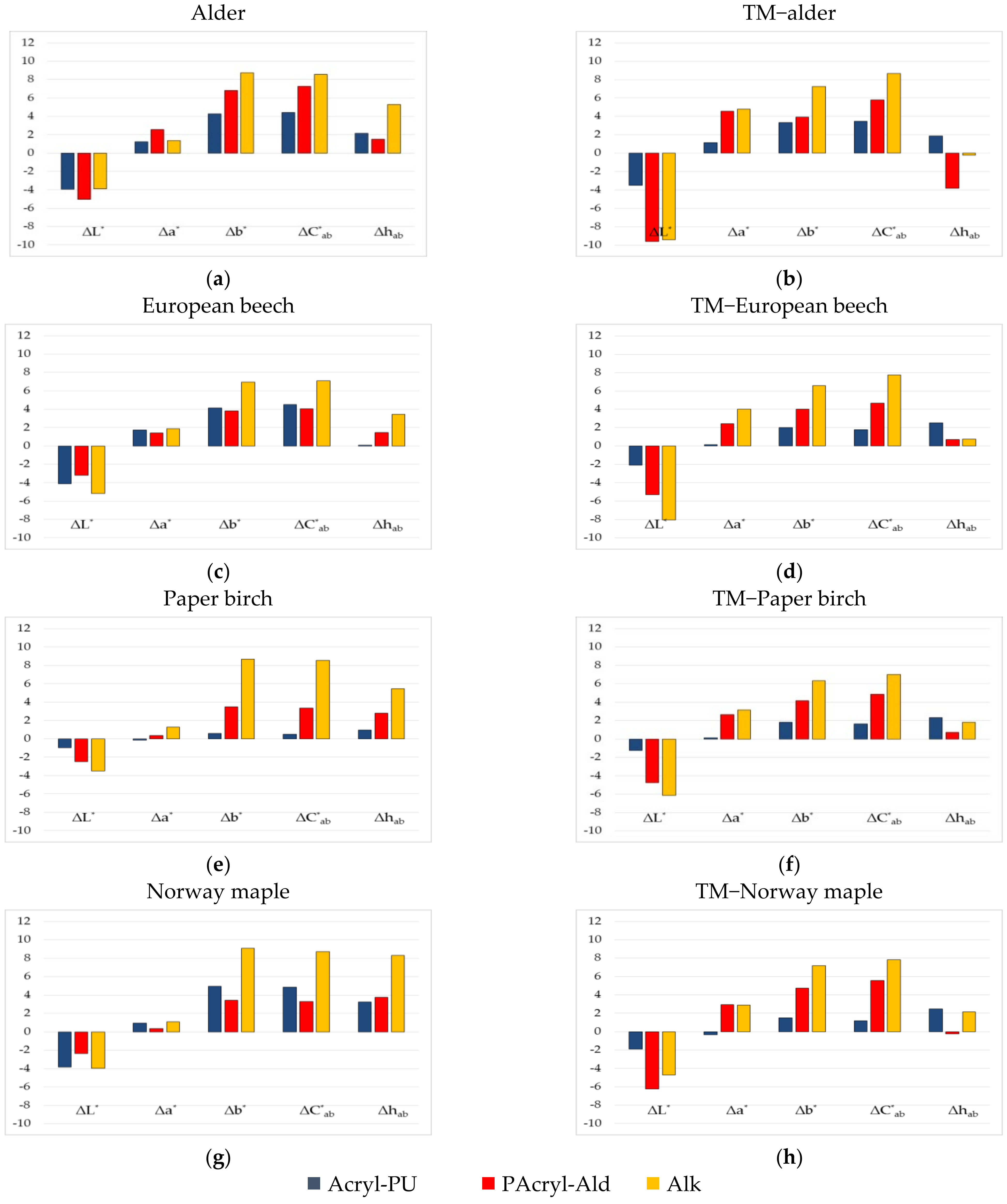
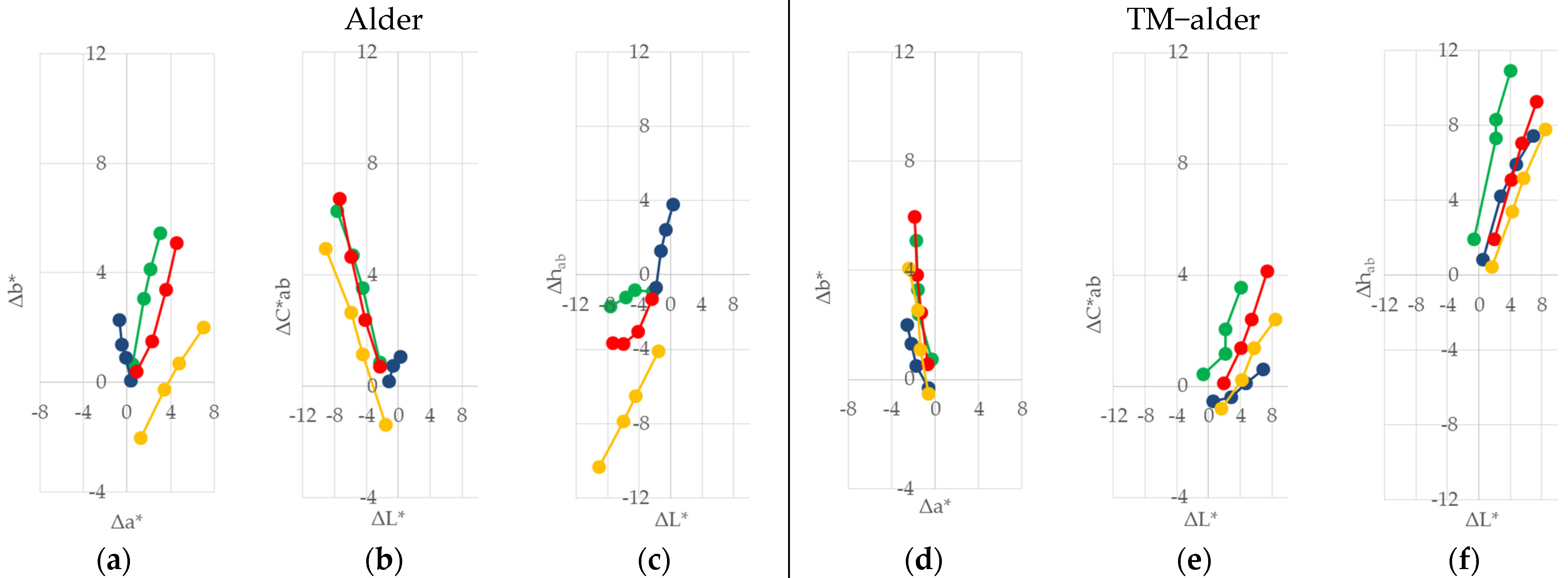
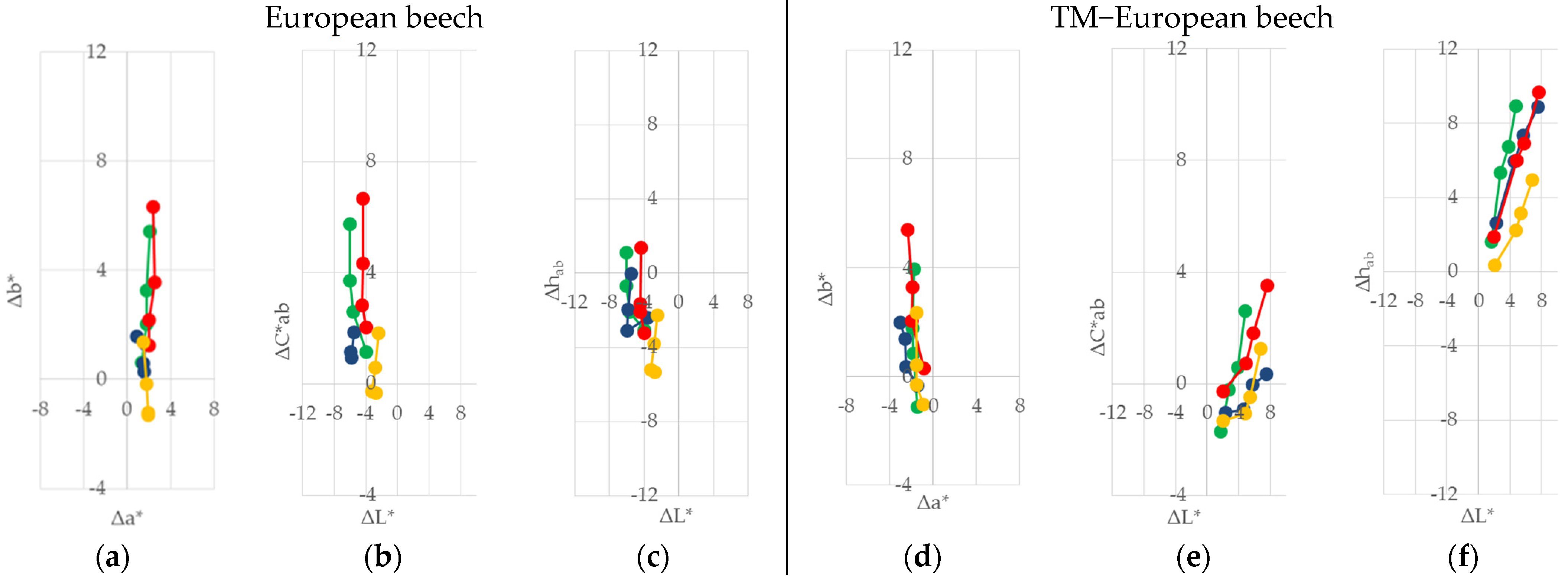
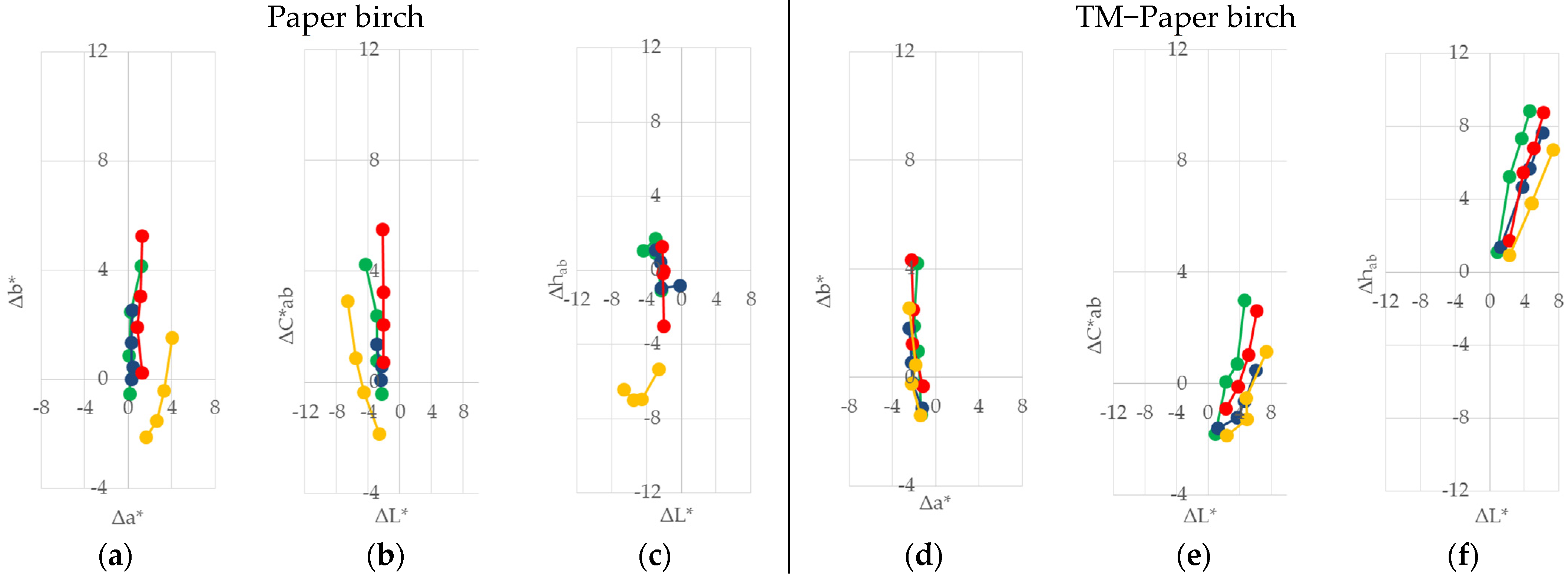


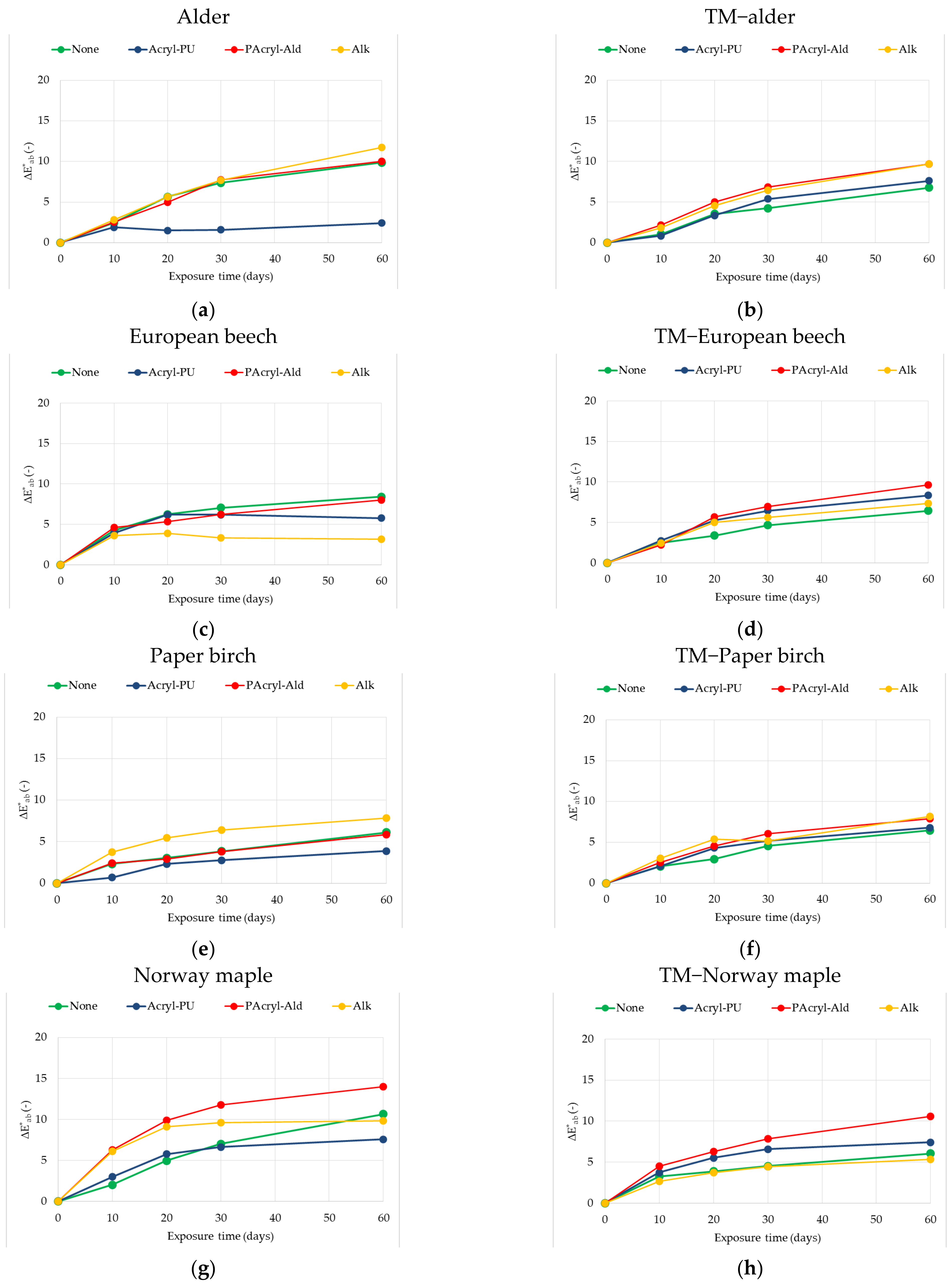
| Finish Product | Acryl-PU | PAcryl-Ald | Alk |
|---|---|---|---|
| Commercial name | Aqua TL-412 -Treppenlack/50 b | PUR SL-212 -Schichtlack/30 b | HWS-112 -Hartwachs-Siegel/clear b |
| Components | One-component | Two-component | One-component |
| Film former | Acrylic/Polyurethane dispersion | Polyacrylic resin, Aldehyde resin | Alkyd resin |
| Gloss | Silk gloss | Semi-matt | Cloth matt |
| Density at 20 °C (g·cm−3) | 1.03 | 0.94 | 0.88 |
| Flow time (s) | Approx. 35 (in DIN 6 cup) | Approx. 30 (in DIN 4 cup) | Approx. 22 (in DIN 4 cup) |
| Spread rate (m·Lm−2) | 100–150 | 80–120 per coat | 1st coat: 70; 2nd coat: 60 |
| VOC content (g·L−1) a | <140 | - | <500 |
| Production of the mixture | Mixing with PUR H-280 100:10 by weight | ||
| Substrate requirements: | Clear, dry, free of dust, grease and loose substances | ||
| -Moisture content (%) | 8–12 | ||
| -Sand grit | P 100–180 | P 100–180 | >P 180 |
| Application/Coat number | Spray/2 | Spray/2 | Spray/2 |
| Temperature of the material, air and substrate (°C) | 18–25 | ||
| Intermediate sanding (Sand grit) | P 240–320 | ||
| Factors | Lightness L* | Redness a* | Yellowness b* | Chroma C*ab | Hue Angle hab |
|---|---|---|---|---|---|
| Wood Species (WS) | 0.000a | 0.018 a | 0.000 a | 0.000 a | 0.000 a |
| Wood treatments (WT) | 0.000 a | 0.000 a | 0.004 a | 0.000 a | 0.000 a |
| Finishes (F) | 0.000 a | 0.000 a | 0.000 a | 0.000 a | 0.000 a |
| Exposure Time (ET) | 0.000 a | 0.384 | 0.000 a | 0.000 a | 0.000 a |
| WS × WT | 0.000 a | 0.358 | 0.741 | 0.546 | 0.000 a |
| WS × F | 0.262 | 0.081 a | 0.000 a | 0.000 a | 0.149 |
| WS × ET | 0.872 | 0.967 | 0.003 a | 0.131 | 0.001 a |
| F × WT | 0.000 a | 0.000 a | 0.004 a | 0.000 a | 0.000 a |
| F × ET | 0.577 | 0.520 | 0.000 a | 0.546 | 0.000 a |
| WT × ET | 0.008 a | 0.734 | 0.129 | 0.002 | 0.000 a |
| Wood Species | Wood Treatment | Density [4,5,6,7] (kg·m−3) | Visual | Lightness L* | Redness a* | Yellowness b* | Chroma C*ab | Hue angle hab |
|---|---|---|---|---|---|---|---|---|
| Alder | Native | 523 (30) |  | 80.33 (0.41) | 7.36 (0.31) | 16.60 (0.31) | 18.10 (0.34) | 66.48 (0.78) |
| TM | 505 (18) |  | 60.38 (1.59) | 11.36 (0.50) | 16.05 (0.32) | 19.67 (0.34) | 54.71 (1.44) | |
| European beech | Native | 684 (65) |  | 78.42 (1.30) | 7.33 (0.52) | 15.37 (0.35) | 17.04 (0.54) | 64.55 (1.15) |
| TM | 705 (68) |  | 59.74 (0.52) | 11.82 (0.22) | 17.54 (0.25) | 21.15 (0.28) | 55.98 (0.53) | |
| Paper birch | Native | 650 (27) |  | 78.36 (0.84) | 7.14 (0.29) | 17.69 (0.53) | 19.09 (0.55) | 68.05 (0.64) |
| TM | 626 (18) |  | 62.26 (0.94) | 10.95 (0.34) | 17.83 (0.25) | 20.91 (0.28) | 58.39 (0.89) | |
| Norway maple | Native | 600 (50) |  | 81.27 (0.77) | 6.00 (0.33) | 15.00 (0.35) | 16.20 (0.26) | 69.64 (0.97) |
| TM | 577 (25) |  | 65.42 (1.01) | 10.49 (0.35) | 19.38 (0.40) | 22.02 (0.40) | 61.58 (0.84) |
Publisher’s Note: MDPI stays neutral with regard to jurisdictional claims in published maps and institutional affiliations. |
© 2021 by the authors. Licensee MDPI, Basel, Switzerland. This article is an open access article distributed under the terms and conditions of the Creative Commons Attribution (CC BY) license (https://creativecommons.org/licenses/by/4.0/).
Share and Cite
Vidholdová, Z.; Slabejová, G. Colour Stabilisation of Surface of Four Thermally Modified Woods with Saturated Water Vapour by Finishes. Polymers 2021, 13, 3373. https://doi.org/10.3390/polym13193373
Vidholdová Z, Slabejová G. Colour Stabilisation of Surface of Four Thermally Modified Woods with Saturated Water Vapour by Finishes. Polymers. 2021; 13(19):3373. https://doi.org/10.3390/polym13193373
Chicago/Turabian StyleVidholdová, Zuzana, and Gabriela Slabejová. 2021. "Colour Stabilisation of Surface of Four Thermally Modified Woods with Saturated Water Vapour by Finishes" Polymers 13, no. 19: 3373. https://doi.org/10.3390/polym13193373
APA StyleVidholdová, Z., & Slabejová, G. (2021). Colour Stabilisation of Surface of Four Thermally Modified Woods with Saturated Water Vapour by Finishes. Polymers, 13(19), 3373. https://doi.org/10.3390/polym13193373








